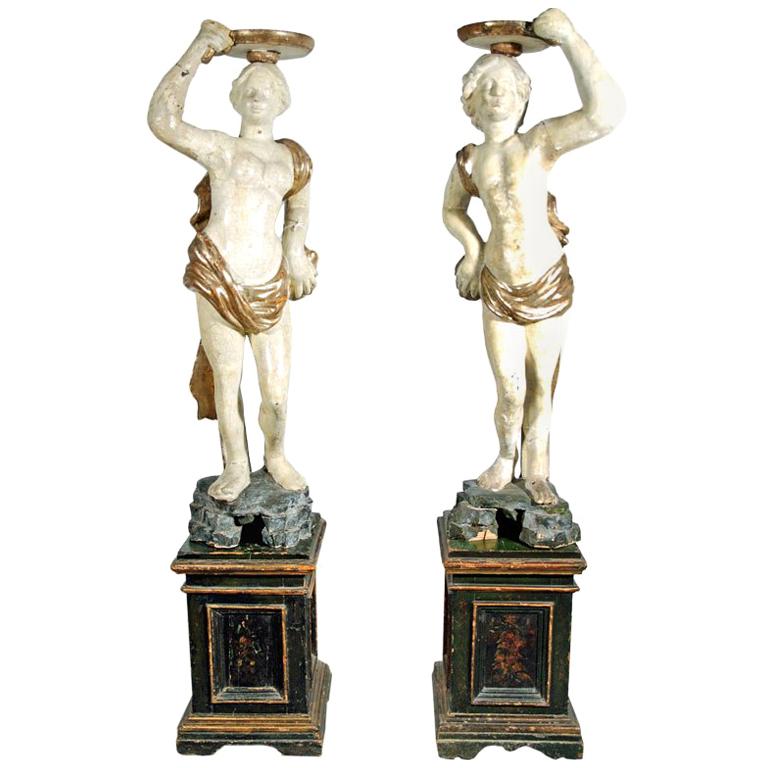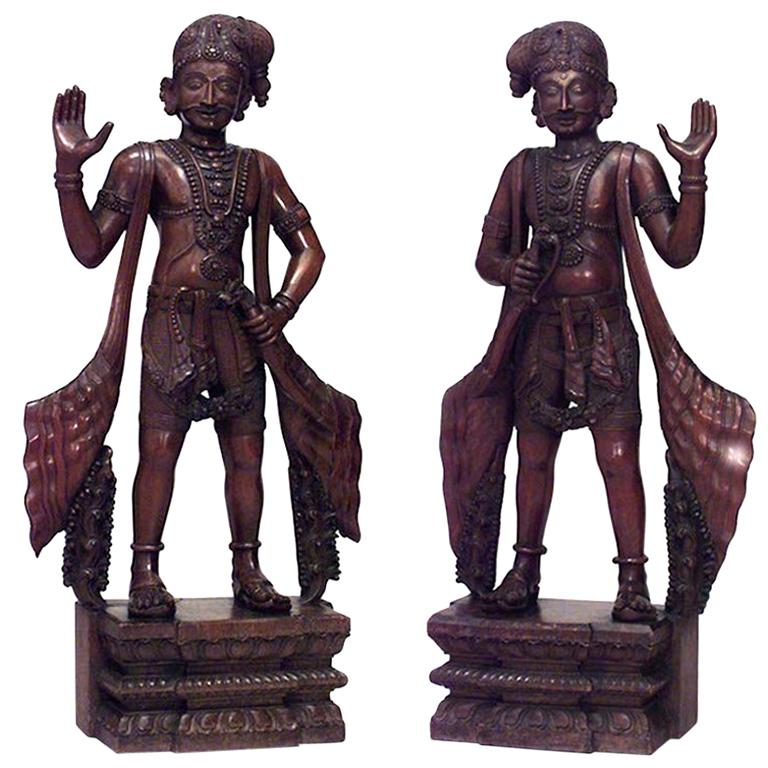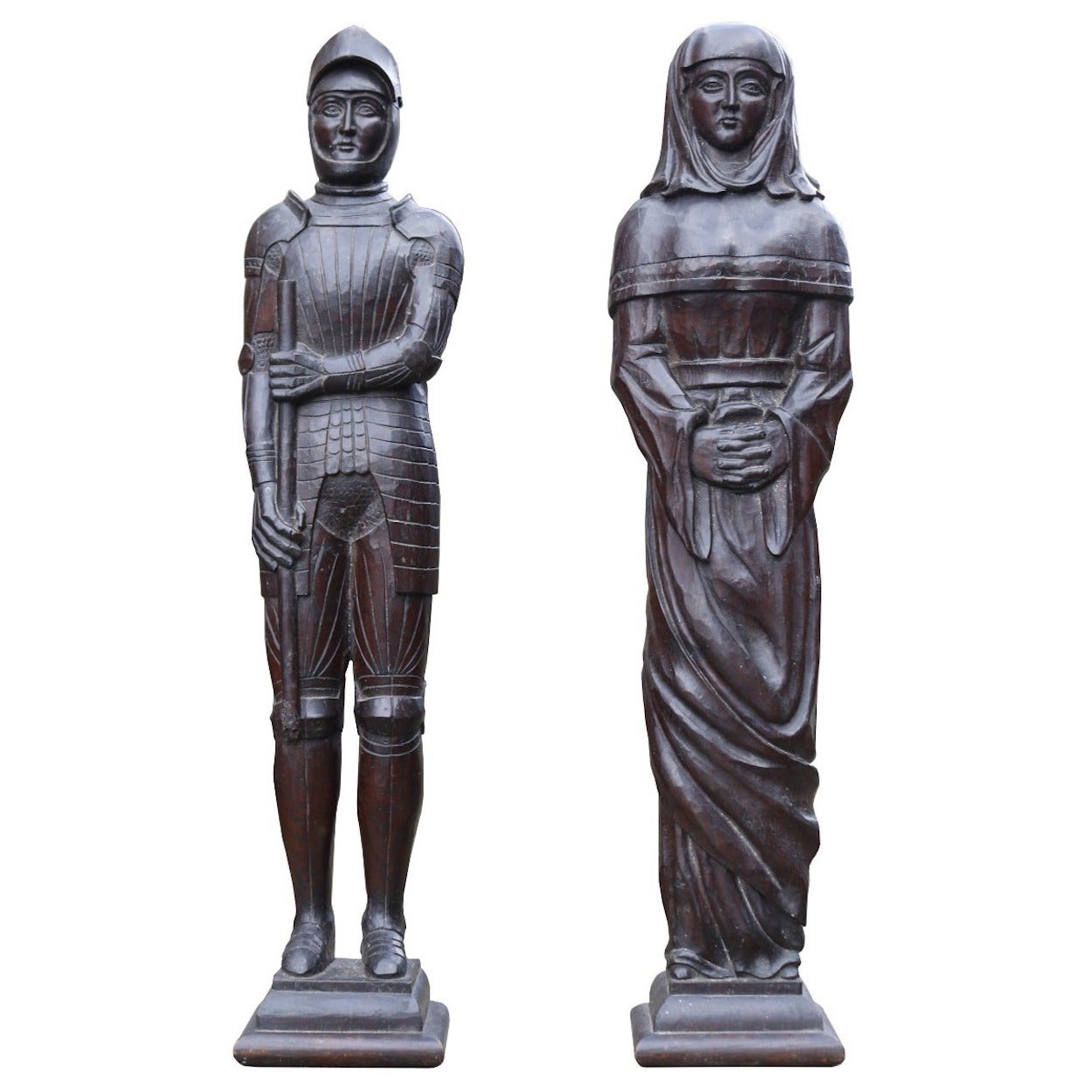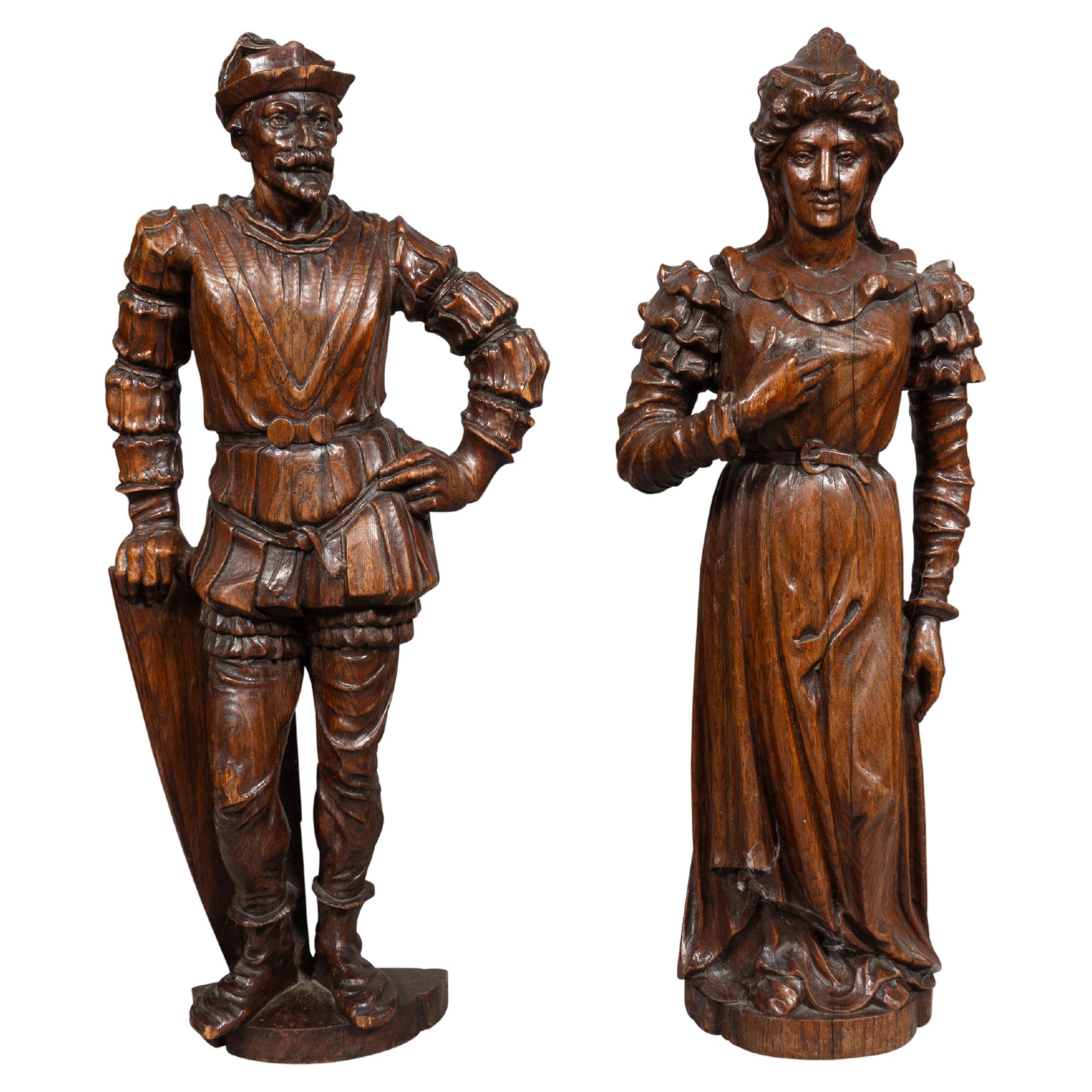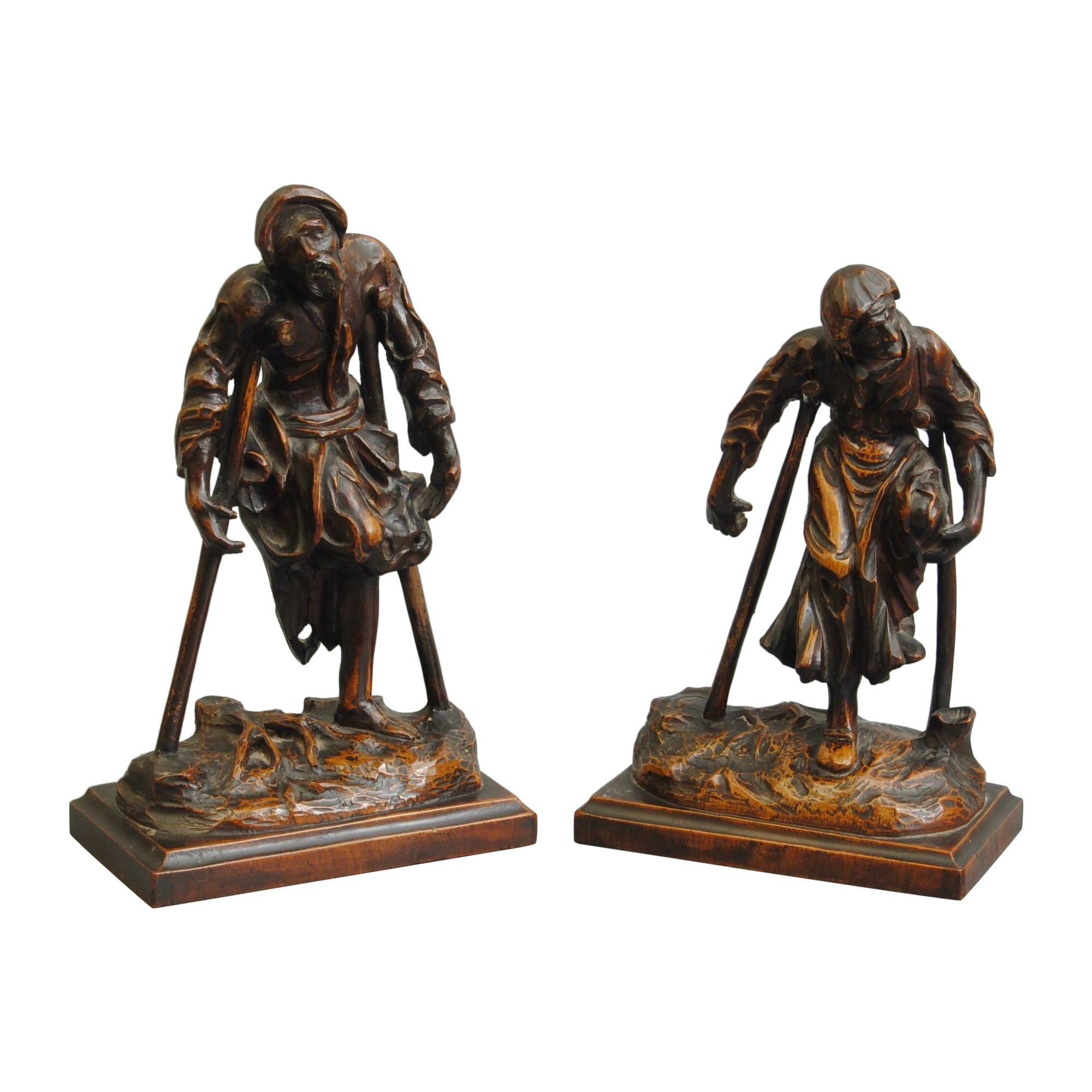Items Similar to A Superb Pair of Neapolitan Carved Figures of Dwarves
Want more images or videos?
Request additional images or videos from the seller
A Superb Pair of Neapolitan Carved Figures of Dwarves
About the Item
A Superb Pair of Neapolitan Carved Figures of Dwarves
Attributed to Francesco Celebrano (1729 - 1814)
Marble
Naples, Italy
18th Century
SIZE: Male: 36cm high - 14¼ ins high
Female: 36cm high - 14¼ ins high
PROVENANCE:
Ex Private collection
Francesco Celebrano was an Italian artist, sculptor and painter. He was well known for producing Neapolitan ‘presepio’ creche figures. A number of his ‘presepio’ figures are housed in museums, including Naples, Bavarian National Museum in Munich and the Metropolitan Museum, New York.
Celebrano trained as a painter and from the 1760s worked as a sculptor, painter and designer in Naples. He painted a number of altarpieces, was commissioned for the sculpture of the Chapel of San Severo in Sta Maria della Pietà and designed the maritime chariot for del d'Ofri, which brought him to the attention of Ferdinand IV (1751 - 1825). He was appointed director of the Royal Porcelain Factory of Naples at Capodimonte in 1770 and remained as its head until 1781. During this time, many models of figures were created at the factory, which may have reflected Celebrano’s interest in and modelling of figures for the Neapolitan ‘presepio’ figures.
- Attributed to:Francesco Celebrano (Artist)
- Dimensions:Height: 14 in (35.56 cm)Width: 8 in (20.32 cm)Depth: 6 in (15.24 cm)
- Sold As:Set of 2
- Materials and Techniques:
- Place of Origin:
- Period:
- Date of Manufacture:18th Century
- Condition:Wear consistent with age and use. Very good overall condition. With an excellent colour and patina through handling.
- Seller Location:London, GB
- Reference Number:1stDibs: LU9363236816042
About the Seller
No Reviews Yet
Vetted Seller
These experienced sellers undergo a comprehensive evaluation by our team of in-house experts.
Established in 1989
1stDibs seller since 2023
- ShippingRetrieving quote...Ships From: London, United Kingdom
- Return PolicyA return for this item may be initiated within 14 days of delivery.
More From This SellerView All
- A Fine Flemish Carved Figure of a ManLocated in London, GBA Fine Flemish Carved Figure of a Man Attributed to Henrick Douverman (c. 1480 - 1543) (sometimes known as Heinrich Douwermann) Wood (oak) Flemish Early 16th Century SIZE: 28cm high...Category
Antique 16th Century Dutch Figurative Sculptures
MaterialsWood
- European Carved Limestone Celtic Votive Head of a Male WarriorLocated in London, GBA Large European Carved Limestone Celtic Votive Head of a Male Warrior Wearing a Typical Flowing Moustache Small Beard and Curling Locks of Hair Stiffened with Lime Wash the Slit Mouth Open as if in Command Circa 1st Century BC - 1st Century AD Size: 31cm high, 22cm wide, 25cm deep - 12¼ ins high, 8¾ ins wide, 9¾ ins deep / 42cm high - 16½ ins high (with base) From about 500 BC, first Greek and later Roman historians mention peoples living in a large area of non-mediterranean Europe as Celts. These classical chroniclers seem to have recognised these communities as having sufficient shared cultural traditions to justify their being given a common name, ‘Keltoi’ by the Greeks, and ‘Celtae’ or ‘Galli’ by the Romans. The earliest allusions to Celts by such Greek historians as Herodotus (485 - 425 BC) were followed by Polybius (200 - 118 BC) and Livy (59 BC - AD 17) who discuss the expansion of the Celts from their central European homelands during the 4th and 3rd centuries BC. They document the presence of Celts in Spain, France, Italy, Greece and Asia Minor, specifically central Turkey. They testify to the successful Roman resistance to the Celts in Italy, after the ignominy of the sacking of Rome by them in 387 BC, and describe the huge defeat suffered by the Celts at the battle of Telemon in northern Italy in 225 BC. The Celts in Greece who sacked the sacred site of Delphi in 279 BC were defeated by King Antigonos Gonatas of Macedon in 278 - 277 BC and in Turkey by Altalus of Pergamon in 240 BC. The Celts in Spain fell under the shadow of Rome from 2nd Century BC and the Celtic heartland known by the Romans as ‘Gaul’ was conquered by the Romans under Julius Caesar in the mid 1st Century BC. Britain was not referred to as Celtic by the ancient historians, but Caesar recognised the close similarities between Britain and Gaul especially in their political organisation. Tacitus (55 - 120 AD) and others chronicled the conquest of Britain between 43 and 84 AD some mentioning the fierce nature of the Celts who went into battle naked. Celtic art therefore belongs to an artistic tradition in the early history of Europe which is no less important than that of the classical world. Art was central to Celtic identity and was closely related to the objects which it decorated. The Celts were used to seeing art as an integral part of their everyday lives. Provenance: Ex Finch and Co...Category
Antique 15th Century and Earlier European Busts
MaterialsLimestone
- An Unusual and Rare English ‘Memento Mori’ Carved Shrine with Two Human SkullsLocated in London, GBAn Unusual and Rare English ‘Memento Mori’ Carved Shrine with Two Human Skulls to the underside, a carved ‘Dragonfly’ Marble 16th / 17th Century England Size: 36cm high, 28cm w...Category
Antique 16th Century English Figurative Sculptures
MaterialsMarble
- A Superb Pair of French Brass Mounted Tortoiseshell Veneered Collectors CabinetsLocated in London, GBA Superb Pair of French Brass Mounted Tortoiseshell Veneered Collectors Cabinets in the Louis XVI Style Wood, Glass, Brass, Tortoiseshell, Horn, Velvet France, Napoleon III Circa 1...Category
Antique Mid-19th Century French Louis XVI Cabinets
MaterialsBrass
- A Very Rare and Important Marble Relief of the ‘Resurrection of Christ’Located in London, GBA Very Rare and Important Marble Relief of the ‘Resurrection of Christ’ Attributed to the Master of the Mascoli Altar Marble Venice, Italy Second half of the 15th Century SIZE: ...Category
Antique 15th Century and Earlier Italian Renaissance Figurative Sculptures
MaterialsMarble
- A Small Bronze Group of a Prancing StagLocated in London, GBA Small Bronze Group of a Prancing Stag Bronze, gilt bronze South Germany; Nuremberg or Augsburg Late 17th Century / Circa 1620 SIZE: 12cm high - 4¾ ins high This bronze group, made in southern Germany, bears great similarities with the gilded silver table...Category
Antique 17th Century German Animal Sculptures
MaterialsBronze
You May Also Like
- A Rare Pair of Neapolitan Papier Mache Figures on PlinthsLocated in Sheffield, MAEach figure is painted and gilded, and each resting on painted and polychromed plinthsCategory
Antique 18th Century and Earlier Italian Sculptures
- Pair of Javanese Carved Teak FiguresLocated in New York, NYPair of Asian Javanese (19/20th Cent) carved teak large figures with drape over shoulder and sword.Category
Antique 19th Century Javanese Dutch Colonial Figurative Sculptures
MaterialsTeak
- Pair of 1940s Carved Soapstone Chinese FiguresLocated in Tarrytown, NYPair of 1940s carved soapstone Chinese figures.Category
Vintage 1940s Figurative Sculptures
MaterialsSoapstone
- Pair of Antique Hand Carved Oak FiguresLocated in Wormelow, HerefordshireA pair of English oak figures depicting a knight and a maiden. These were previously part of a panelled room constructed from earlier pieces of architectural salvage and assembled in...Category
Antique 18th Century Figurative Sculptures
MaterialsOak
- Pair Of European Carved Figures Of A Man And WomanLocated in Essex, MAFeaturing a man and woman in 19th century dress. Well carved .Category
Antique 1850s European Victorian Figurative Sculptures
MaterialsOak
- A PAIR OF FINELY CARVED BOX WOOD Figures Of BeggarsLocated in Lincolnshire, GBA pair of 18th century German figures of one legged beggars after the engravings of Rembrandt in box wood. Circa 1780Category
Antique Late 18th Century German Figurative Sculptures
MaterialsBoxwood
Recently Viewed
View AllMore Ways To Browse
Italian Creche
Used Creche Furniture
Neapolitan Creche
Carrara Marble Sculpture Dress
Bronze Metal Sculpture Female
Sculpture Casting Sculptures
Chinese Glazed Figurine
Benin Currency
Bc Binning
Lladro Gladiator Figurine
Muriel Castanis
Austrian Gold
Aged Copper Sculpture
Anatomical Figure
Bronze Puzzle
Faguays Bronze
Slender Statue
Gossamer Wings
